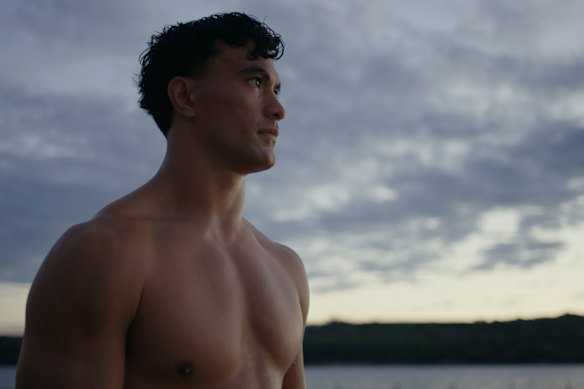The money and magic of Suaalii Inc
By Frances Howe
Joseph-Aukuso Suaalii made the short walk to his parked matte black Land Rover Defender on Lansdowne Street in Sydney’s trendy inner-city suburb of Surry Hills. He’d just spent the day at a photo shoot for GQ magazine, dressed in more than $35,000 worth of luxury fashion goods and was carrying three tangerine-coloured Louis Vuitton shopping bags full of clothes back to his car.
In a video uploaded to his Instagram from that day, the 21-year-old flashed more than $140,000 worth of goods in just one minute and 49 seconds. Though he’s paid millions to play rugby, he likely kept the clothes for free.

Joseph Suaalii takes his Louis Vuitton bags to his Defender in Surry Hills.Credit: Joseph Suaalii
He’d arrived at Debut Studios earlier that day wearing a $225 jumper – a bargain compared to the outfits he would change into. In one shot, Suaalii wears a $3500 baby-blue mohair sweater paired with jeans worth $3150 and sneakers that cost $845 for each shoe. On his wrist, a stainless-steel watch worth $35,000. In another, a rugby polo, only this one costs $2620, described as taking a “chic twist” on the sportswear.
In an ironic detail from that day, Debut Studios sits in Suite 61 on the sixth floor of the building. As Suaalii walks into frame, he looks out of an open window, offering a direct view of the Sydney Roosters club grounds he left last year for a deal with Rugby Australia worth $5.4 million. He turns back around, fixes his $2000 shirt and faces the camera.
Although being a teen sporting prodigy and achieving early career success on the field has increased the commercial value of Suaalii’s name, there’s more that separates his brand’s capacity for profit from his teammates.
Professor in sport management Adam Karg said what you look like, who you know, and how you behave are also significant in a brand choosing you to work with, especially one worth as much as Louis Vuitton’s $51 billion brand.
“In order to be able to commercialise that brand, you do need, rightly or wrongly, a really strong set of eyeballs. Essentially, you need to be able to generate media interest,” Karg said.
“Now, that can come through physical appearance. It can come through, obviously, on the field, performance being a degree of that as well, and then really you need a brand to see something in you that connects with them and their audience.”
As Suaalli’s profile grows, so do the opportunities for gain. Of the six search terms Rugby Australia tracked in its 2024 financial review, only one player’s name was listed; Suaalii was mentioned 10,000 times in all media in the four months after switching codes, and the attention hasn’t slowed as the Lions Tour arrives and the 2027 Rugby World Cup approaches.
Louis Vuitton’s deal with Suaalii makes sense for a brand that has begun rapidly expanding its influence in the sporting world. Last year, it invested an estimated $267 million into the Paris Olympic Games to become the tournament’s “premium partner” before being named title sponsor of the 2025 Australian Grand Prix as part of a larger $1.6 billion deal with Formula 1.
Alongside tournament partners, the brand has paid large sums to expand its collection of athlete ambassadors. Carlos Alcaraz is the highest-paid tennis player in the world, thanks in part to signing with the brand in 2023 for a reported $65 million.
Suaalii isn’t an official ambassador — yet. Instead, he and the brand are still in the courting phase. On top of supplying clothes for the shoot with GQ, Suaalii attended the Australian Grand Prix as a guest of Louis Vuitton this year. While there, he was photographed alongside the All Blacks’ Dan Carter, who has held official ambassador status since 2023. Similarly, French rugby player Antoine Dupont was made an ambassador last year, further staking Louis Vuitton’s hold over the code.

Joseph-Aukuso Suaalii in Stan Sport’s promotional material for the British and Irish Lions Tour. Credit: Stan Sport
Beyond individual brands, Suaalii has become the poster boy for Australian rugby, isolated from his teammates and pictured alone in advertisements, including in Stan’s Lions Tour campaign launch, where he stands shirtless and alone at the edge of a glossy ocean pool.
His isolation from the rest of the team is a helpful marketing tool in the age of social media, when athletes can turn into profit-generating influencers with a single Instagram post.
Kaye Chan is a senior lecturer in marketing at UTS and has researched the transition from marketing in traditional media to online platforms.
“The reason brands are using these personalities, or you could even call them influencers of a type, is because they have such an organic audience, so they have this reach, this attention of people that you may not be able to access in other ways,” she said.
For Suaalii, the “influencing” has taken some adjusting: “I’m just a kid from western Sydney ... So to be working with a brand like Louis Vuitton and Defender, it’s definitely something I don’t take for granted,” he said.
“I remember the first proper drive I did in it [the Land Rover] was with my dad. He’s super proud, and that moment was fun.”
Where more traditional advertising is hidden behind subscription costs, younger markets flock to social media. The platforms also provide brands with quantifiable reach by counting followers, views, likes, comments and shares.
Though he is not yet an ambassador, Suaalii arrived back home to his $1.5 million Double Bay apartment to unpack his Louis Vuitton shopping bags after the shoot. His Defender 110 a far cry from his first car, a hand-me-down Toyota Camry. At home, he discards the $225 jumper to the couch, and while he opened the rest of his gifts, he wore a $1770 pale green crew neck, complete with “Louis Vuitton” embroidered across his chest.